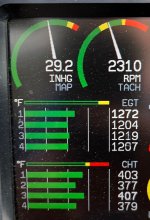Hi guys,
I am flying a RV-9 with a Lycoming O-320-D2J, James holy cowl, one magneto and one P-Mag, burning Avgas 100LL. In the cruise I am seeing CHT's between 370 and 400F, more so during the climb. Rather unhappy about that. I heard a story that changing the timing on the ingnition may improve and even dramiatically improve CHT's but I am far from an engine expert.
Any first thoughts on a way of lowering the CHT's ??

I am flying a RV-9 with a Lycoming O-320-D2J, James holy cowl, one magneto and one P-Mag, burning Avgas 100LL. In the cruise I am seeing CHT's between 370 and 400F, more so during the climb. Rather unhappy about that. I heard a story that changing the timing on the ingnition may improve and even dramiatically improve CHT's but I am far from an engine expert.
Any first thoughts on a way of lowering the CHT's ??





